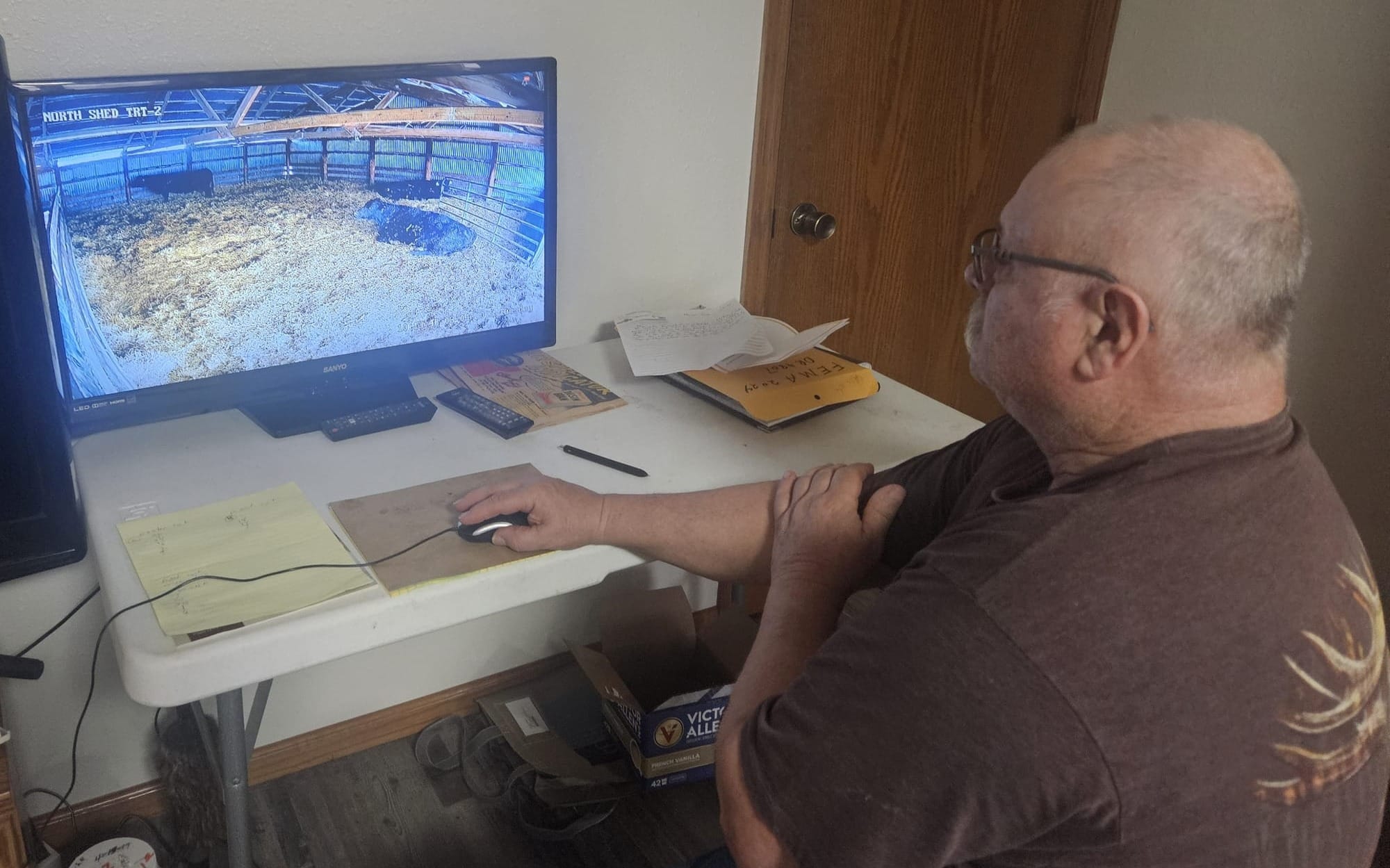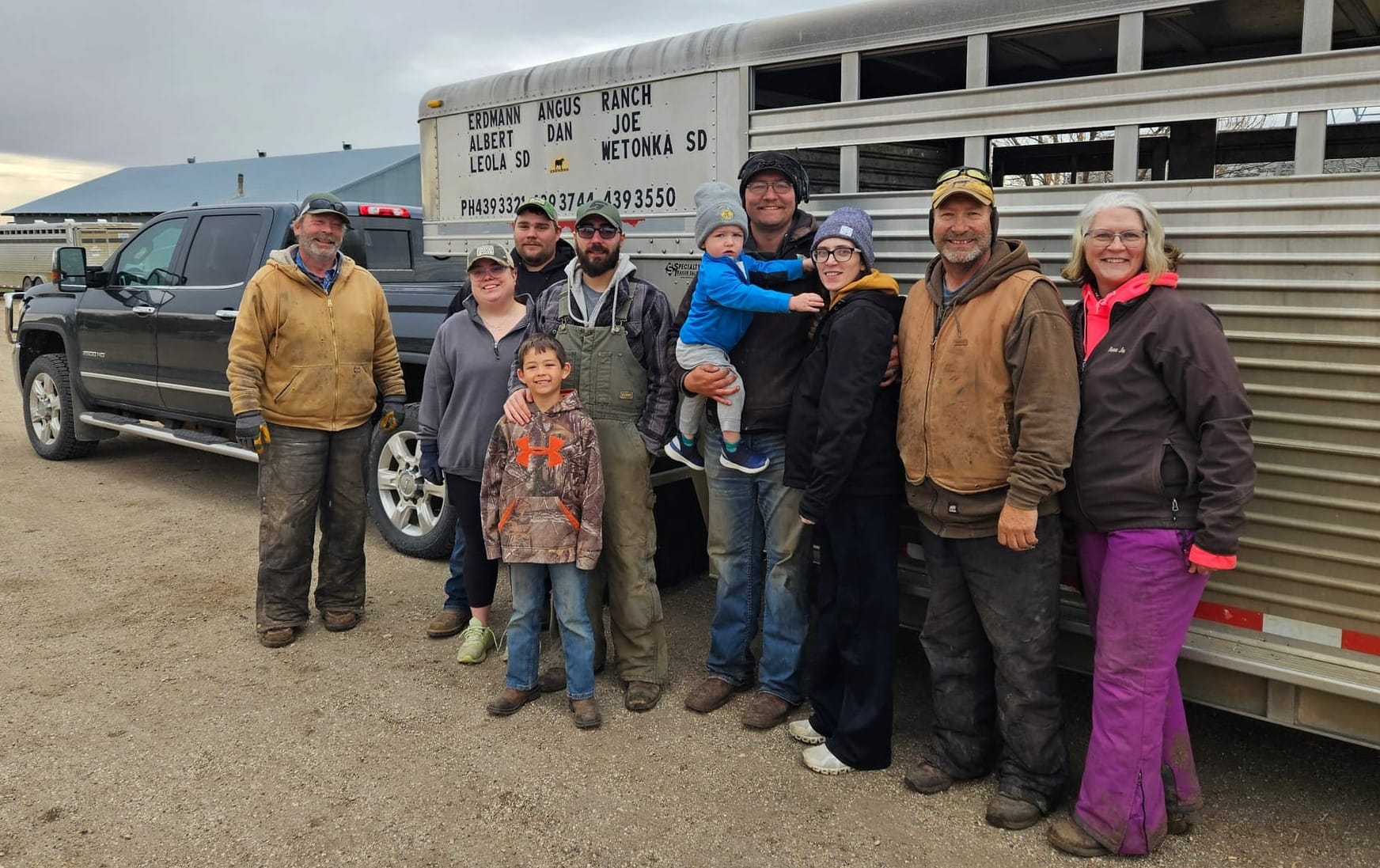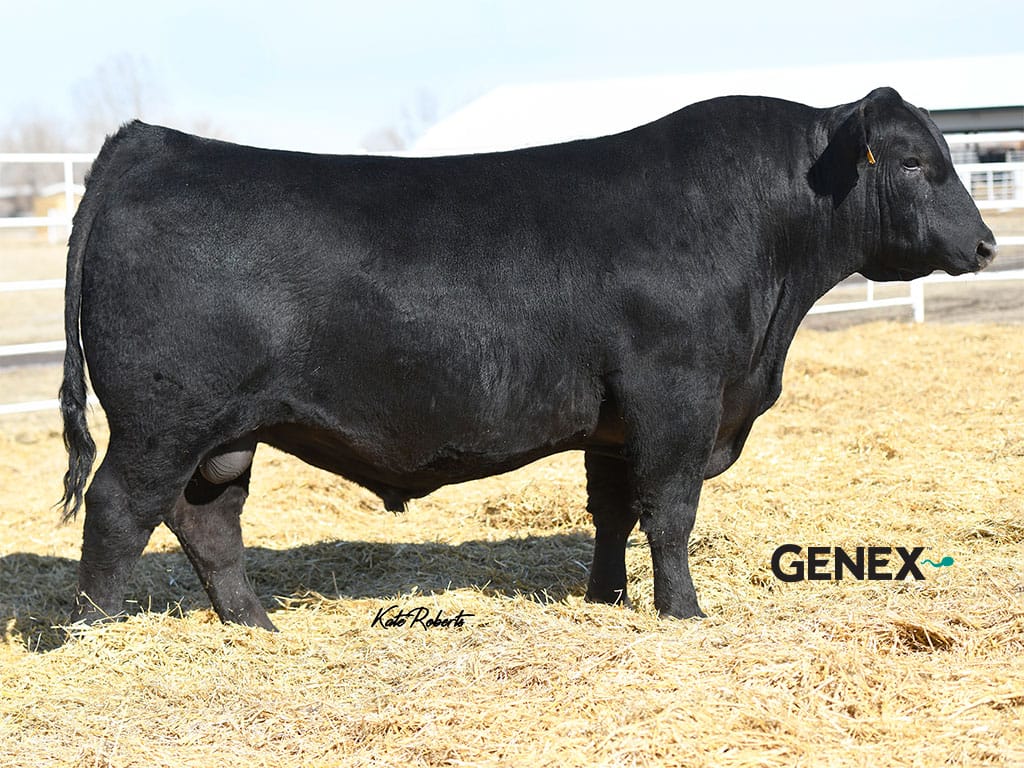 Megan Luther/ South Dakota News Watch
Megan Luther/ South Dakota News Watch
MITCHELL, S.D. – The snow’s blowing sideways, the heavy stuff. It’s one of the few winter storms this year and it happens to fall on the first days of March, calving season.
I arrive at Steve Easton’s farm in Hanson County in southeastern South Dakota, prepared, wearing long underwear, snow pants, ski mask. What I was not prepared for was finding Steve, in a T-shirt and jeans sitting at his kitchen table.
“You look like you’re dressed for bad weather,” Steve smiles.
He has no plans to go outside today. And he doesn’t need to. From where he sits, he has a crystal-clear view of those cows that are close to labor on a TV divided into eight smaller screens, one for each camera.

One screen shows a cow standing, sometimes slightly swaying looking uncomfortable. Is she due soon? Steve pulls out his smartphone and opens an app connected to the cameras. “On the phone, you can actually enlarge it.” He zooms in on the ear tag. The number confirms she’s the one that’s due any day now.
I was shocked: “That is insane.”
The last brush I had with calving was in the early ‘90s at a friend’s ranch, where every two hours they rode a four-wheeler through the pasture to check on cows.
Record low cattle numbers
I had intended to write about hard-working, down-to-earth South Dakotans. Lately, any national news about our state dealt with politics. South Dakota’s more than that. It’s calving season, so I searched for a rancher.
But Steve’s calving cameras blew me away — and led me on another journey to understand how science and technology have made calving more efficient. Read: saving money.
The number of cattle in the U.S. today is at a record low, numbers not seen since 1951, according to the U.S. Department of Agriculture. Over the years, historic drought conditions left little food for cows in the pasture and forced producers to sell their herds.
In 2024, Americans ate around 59 pounds of beef on average, up from the year before, according to the USDA. Short supply and strong demand mean a higher price. Add a recent temporary ban on importing beef from Mexico due to a parasite and USDA estimates that beef prices will hit new highs in 2026.
Ranchers are looking for efficiency: How to consistently produce the best beef that consumers want. In South Dakota, it’s big business with four times as many cattle as humans.
The cost of raising cattle for beef is an investment. Depending on feed costs and operation size, producers can spend hundreds to thousands raising a single animal before it goes to slaughter, confirms Erin DeHaan, South Dakota State University professor and extension beef specialist.
Too expensive to just cross their fingers and pray that it all works out.
A family affair
Easton calves part-time. In search of a larger, full-time calving operation, I traveled just 10 miles from the North Dakota border near Leola to a fourth-generation ranch with around 1,000 head of cattle. Turning off the gravel road, I pass under a 16-foot tall wooden archway with a large sign “Erdmann Ranch” hanging from the top.
A red tractor-trailer is backed up to the cattle corral. A handful of Erdmann family members are loading up their Black Angus heifers — each weighing around 1,100 pounds. These are year-old cows that have yet to get pregnant.
“Hupt! Here we go girls,” commands the matriarch, Anne Jo Erdmann. Anne pronounced Annie, or just call her AJ. “One of my boys gives me crap. He goes, ‘Mom, you’re a 56-year-old grandma. You don’t need to use initials anymore.’”
But AJ is easier than people repeatedly misspelling Anne Jo. “It pisses me off.”
She’s easy to spot with her purple snow pants and hot pink hoodie poking through her winter coat.
She’s joined by her son, husband, his brother, nephew and his wife. They use various commands to get the heifers to move. “Haaww!” “Let’s go ladies.” There’s a lot of whistling and counting. They need to fit 58 on this load.
The heifers stomp and moo in protest. The Erdmanns use a cattle prod and paddle to get them moving as they funnel through, single file, up the ramp and into the back of the two-story trailer.

In the corral, Anne Jo endearingly calls out “Hey, Lovey.” Does she call all heifers by that name? No – Lovey, or No. 463, is special.
She looks the same as the others with her jet-black hide. But Lovey’s calm demeanor makes her stand out as they are loaded onto the tractor-trailer. Lovey came from a very planned pregnancy, an investment aided by technology that started before she was even a twinkle in a bull’s eye.
The other AI
Whether Lovey’s life will be a success has been tested for generations by trial and error.
“We’re kind of rigorous. We’re kind of picky,” says Anne Jo.
The Erdmanns prefer cows with structurally correct feet and legs, features that indicate a long lifespan. Angus can live up to 10-15 years. They want cows with nice round udders and good teeth and temperament, indicators of being a nurturing mama.
All those features are held by another cow, Queen of Wetonka, named after the tiny town of 16, south of Leola. When a cow has a name, she’s a prize, a nice pet deserving of special treatment.
Queen of Wetonka has been with the Erdmanns for years and already had birthed three calves by 2023 when they were ready to breed her again. They will use the other AI — artificial insemination.
But first they have to choose a bull.
The bull: By the numbers
It’s a family research effort. Anne Jo, her husband, Dan, their son, Royce, and his Uncle Joe all flip through glossy magazines with high-quality profile photos of bulls, complete with bios and stats. Like a dating profile but with more accurate information.
They search online profiles and talk to other ranchers about their favorite bulls.
Anne Jo is also a sperm dealer. She sells and delivers straws of bull semen to customers. She got an alert about a young bull out of Montana named Spectrum. “We liked his numbers. We liked his pedigree,” Anne Jo says.
One look at his profile page and you can see why. His photo, taken by a professional photographer, shows a side profile of pure black Spectrum standing in fresh hay. This literal stud was born on Valentine’s Day in 2020.

His bio speaks for itself: “He is the perfect combination of Cow Sense & Science and will raise the bar for nearly every measurable trait.”
Below Spectrum’s auspicious birthday is his scrotal circumference: 40 cm, or about 16 inches. The science behind the size shows positive correlation with his daughters maturing early and allowing them to become pregnant sooner. And typically, the bigger the size, the greater the sperm count, which increases the likelihood of pregnancy.
But there is such a thing as too big. It’s a sign of an injury or a growth, both red flags for fertility.
